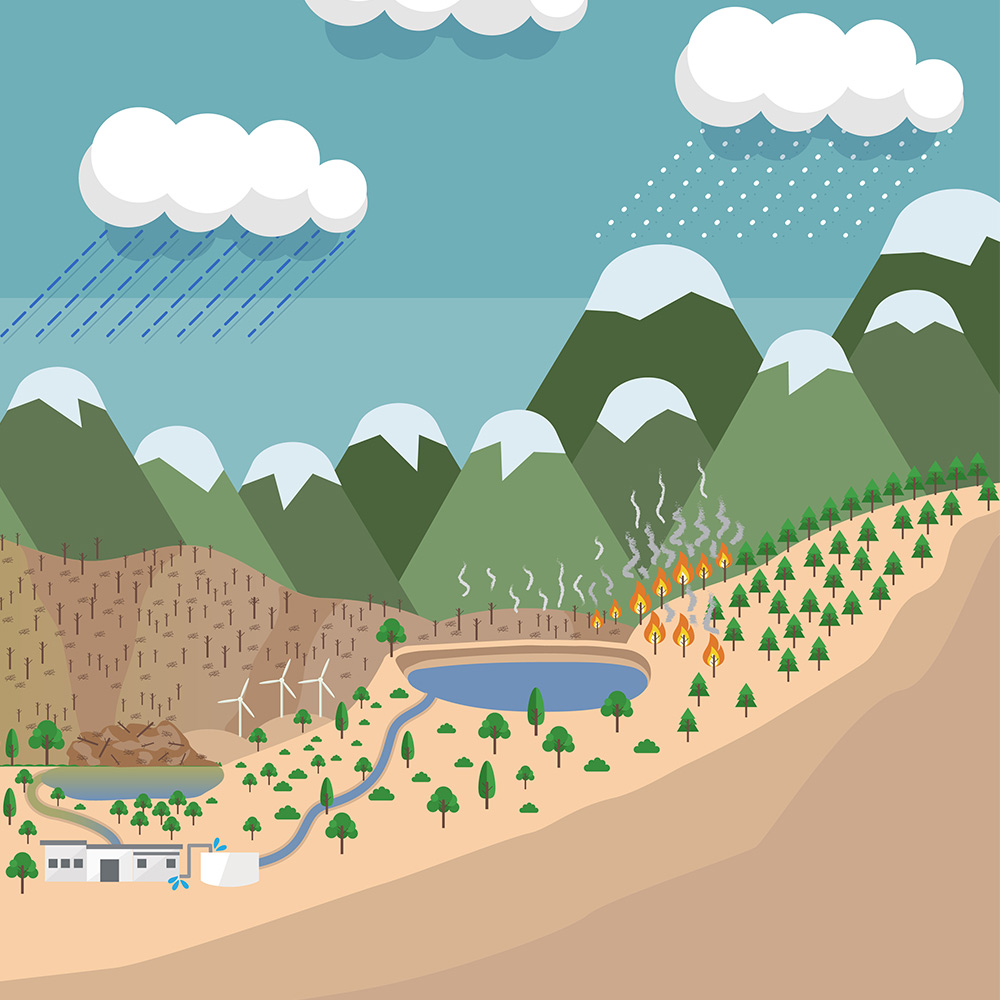For most Americans, climate change evokes images of polar bears stranded on melting icebergs or dying corn stalks surrounded by brown, cracked earth. As resource managers, we know climate change and the extent of its impacts vary by region. Communities along the eastern seaboard are focused on sea level rise and the increasing frequency of hurricanes. Midwestern regions are plagued with ever increasing severe flood events. To the west of the Sierra Nevada Mountains, our clients are dealing with drought, flooding, sea level rise, and wildfires. As a national firm, our experts are aware of these disparate consequences of climate change and working with our clients to properly plan for resiliency.
Fueling the fire and water quality
In California, last year proved to be the worst on record for wildfires. According to the California Department of Forestry and Fire Protection (CAL FIRE), there were over 10,000 wildfires in 2020 that burned nearly 4.2 million acres, totaling more than four percent of the state’s land. These numbers are a sharp increase over 2019, during which there were 5,687 wildfires that burned 137,126 acres. There is overwhelming consensus that climate change adds fuel to these fires. A combination of increasing temperatures, dense and dry vegetation, and shifting rain and snow patterns proves to be the perfect tinderbox. The result? A fire season that lasts all year long with megafires that are burning hotter, longer, and more intensely than anything our collective memories have witnessed.

While it is evident that these massive fires impact homeowners, local economies, and air quality, the blazes also have long-term impacts on critical water resources. For example, after the 2017 Tubbs and 2018 Camp fires, unsafe levels of the carcinogen benzene were found in water samples from the city of Santa Rosa (Tubbs fire) and town of Paradise (Camp fire). Wildfires can also alter surface soils and decrease infiltration during heavy storms, thereby accelerating the movement of water, sediment, and debris to nearby surface water bodies. After the 2017 Thomas fire, Santa Barbara experienced a series of mudflows in early 2018 that caused nearly $230 million in property damage, emergency response services, and cleanup. The debris flows not only resulted in property damage, but also caused significant treatment issues downstream at the water treatment plant.
Approximately 80 percent of the country’s fresh water originates on forested land with more than 3,400 communities reliant on public drinking water systems located in forestland watersheds. In California, wildfire has the potential to impact the more than 32 million people that rely on water supplied by rivers, lakes, reservoirs, and other surface water sources.
Using data to forecast and adapt
Predicting how climate change will impact local water resources begins with forecasting how historical climate change patterns interact within a unique geographic setting. Inputting downscaled General Circulation Models (GCMs) climate data in lieu of historical data sets into existing systems and hydrologic modeling platforms, we can better forecast how changes in precipitation patterns and temperature could impact local topography, hydrology, and ecology. Our experts have used this methodology to predict the timing and volume of runoff available for capture in surface water reservoirs, which allows us to create system operation scenarios, providing adaptation tools in the face of changes in seasonal water availability relative to predicted changes in demand patterns.
In areas prone to wildfire, we can use downscaled data with watershed hydrologic simulation tools and predictive fire models to create Water Quality Vulnerability Zones. This modeling helps determine potential impacts wildfires may have on source reservoirs. This innovative modeling bettered our understanding of how wildfires and historic drought impacted water quality and sedimentation issues in Lake Cachuma, the principal source of drinking water for 200,000 residents in Santa Barbara County. Our team used this modeling to understand post-fire vegetative recovery, erosion, and sediment yield. Additionally, it informed the development of a plan to provide ongoing water sampling and water quality monitoring to gain insight to the relationships between fire, erosion, and source water quality, as well as the efficacy of management strategies.
Downscaling large, complex GCM datasets provides useful information to assess risk and support informed decision making. Our water resource professionals collaborate with our data and information management specialists to develop methods and tools to best package and leverage large databases to effectively use as inputs into water resource systems modeling frameworks. Armed with justifiable analytical results, water managers can take critical steps towards adapting to current and future climate specific changes in their communities. Our water resources, municipal planning, regulatory, and operations experience provides our experts the skills to collaborate with water managers and determine how to best incorporate climate change forecasting and planning into existing plans and initiatives for a holistic, consistent messaging and result.
While adapting to and mitigating future climate change impacts comes at no small investment to utilities and taxpayers, our funding team is positioned to identify and secure grants and loans to fund critical risk assessment and climate change work. These individuals are well versed in available funding sources and track future opportunities. This includes the Biden Administration’s early focus on climate change and the numerous funding opportunities at the state and federal level to support climate change work from risk assessment to capital planning and project implementation.
Want to learn more? Keep an eye on our events page to register for the free webinar on this topic coming up in June with Katie Cole, Water Resources Planner, and Andree Johnson, Project Manager 2, who contributed to this blog.
